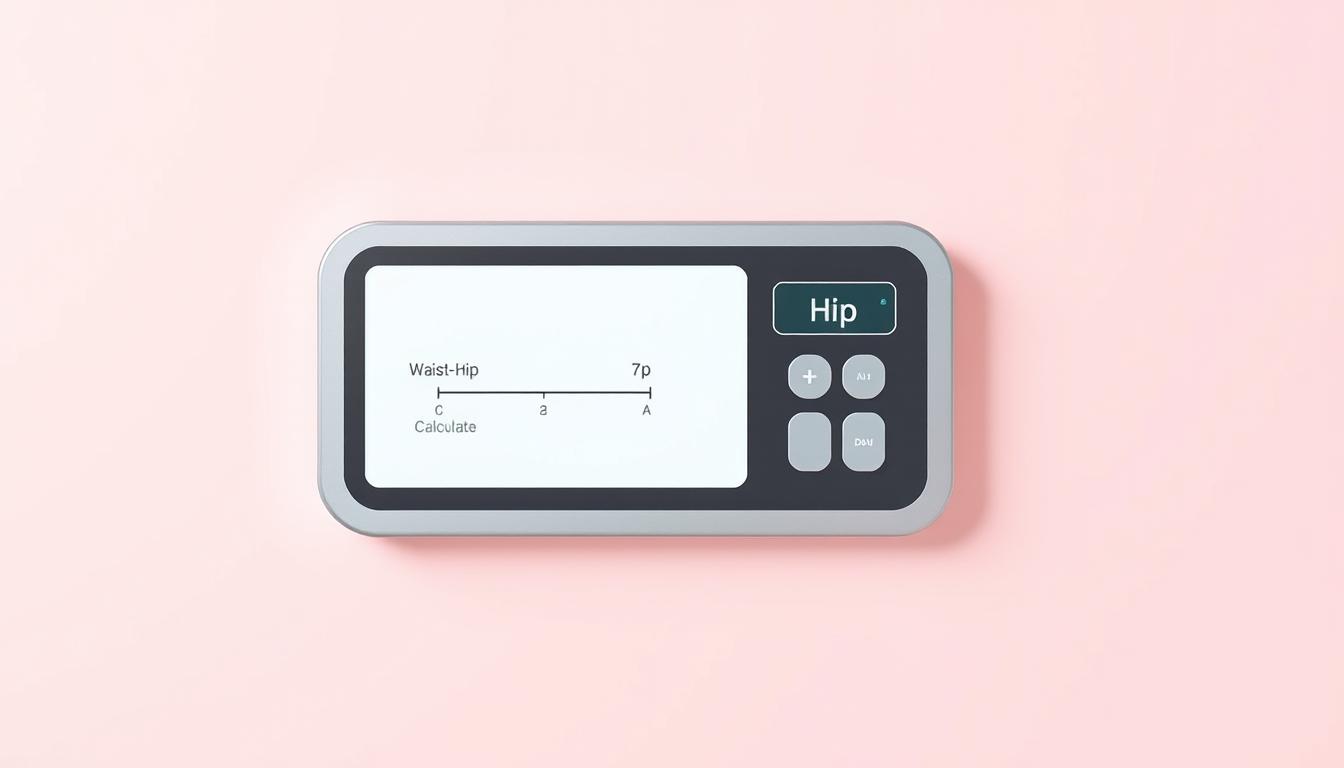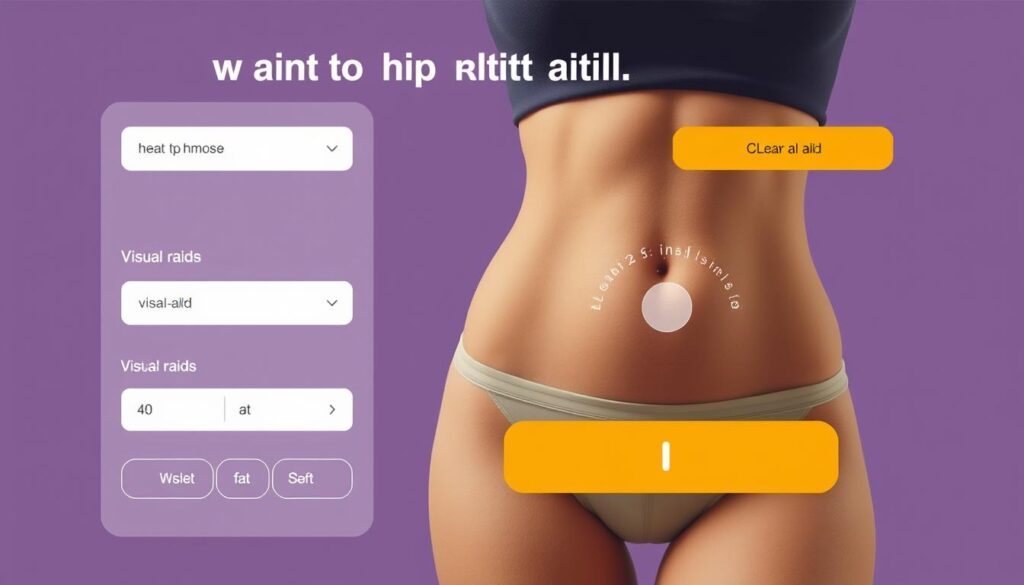“The greatest wealth is health.” – Virgil. This ancient wisdom holds true today, as maintaining good health is a top priority for many of us. One crucial aspect of health is body fat distribution, which can significantly impact our risk of developing serious health conditions.
Research has shown that people with more weight around their waist are at a higher risk of health issues than those who carry weight around their hips. To assess this risk, we use a simple yet effective tool: the waist-to-hip ratio calculator. This calculator estimates the dimensionless ratio of the circumference of the waist to that of the hips, providing valuable insights into our health.
By using this calculator, we can gain a better understanding of our body fat distribution and potential health risks. In this article, we’ll explore the importance of this measurement and how it can help us take control of our health.
Key Takeaways
- Learn how to assess your body fat distribution using a simple calculator.
- Understand the importance of waist-to-hip ratio as a health indicator.
- Discover how your body shape can impact your health risks.
- Find out what the scientific evidence says about the role of fat distribution in health.
- Get an overview of how the calculator works and what it can reveal about your health.
Understanding Waist-to-hip Ratio
We explore the concept of waist-to-hip ratio and its implications for overall health. The waist-to-hip ratio (WHR) is a simple yet effective measure that has gained significant attention in recent years due to its potential to predict health risks more accurately than some traditional metrics.
What Is Waist-to-hip Ratio?
The waist-to-hip ratio is calculated by dividing the circumference of your waist by the circumference of your hips, resulting in a ratio that indicates your fat distribution pattern. This measurement is used as an indicator of obesity and health risks associated with it. A higher ratio indicates a higher amount of visceral fat around the organs, which is linked to various health issues.
Why WHR Matters More Than BMI
While BMI (Body Mass Index) is widely used to diagnose obesity, it has its limitations as it doesn’t account for fat distribution. The waist-to-hip ratio, on the other hand, focuses on where fat is stored, providing a more nuanced view of health risks. Research suggests that WHR can be a better predictor of certain health risks, such as heart disease and type 2 diabetes, than BMI alone.

- Waist-to-hip ratio is a measure of fat distribution.
- It differs from BMI by focusing on fat storage locations.
- A higher WHR indicates greater health risks.
How to Measure Your Waist-to-hip Ratio Correctly
Understanding how to measure your waist and hip circumferences is vital for an accurate waist-to-hip ratio calculation. To achieve this, you need to follow a precise method.
Measuring Your Waist Circumference
To measure your waist circumference, use a flexible but stretch-resistant tape measure, such as a tailor’s tape. Stand upright with your weight evenly distributed between both feet. Locate the midpoint between the last palpable rib and the top of the iliac crest. Wrap the tape around this point, ensuring it’s parallel to the floor and snug but not compressing your skin. Take the measurement after exhaling normally.
It’s essential to identify the correct anatomical location for the waist measurement. The tape should be positioned at the smallest circumference of your natural waist, usually just above the belly button.
Measuring Your Hip Circumference
For hip circumference, measure around the widest portion of your buttocks, keeping the tape parallel to the floor. This is typically at the widest part of your buttocks or hip. Ensure the tape is not too tight or too loose, and take the measurement while standing upright.
To ensure accuracy, consider having someone assist you with these measurements. If measuring yourself, use a mirror to verify the tape’s position.
Waist-to-hip Ratio Calculator for Health
Get instant insights into your health with our easy-to-use waist-to-hip ratio calculator. Our calculator is designed to help you understand your body shape and associated health risks.
How to Use Our Calculator
Using our waist-to-hip ratio calculator is straightforward. Simply choose your preferred unit of measurement for waist and hip circumference, enter your measurements, and you’ll instantly see your waist-to-hip ratio.
Our calculator uses the standard formula of waist circumference divided by hip circumference to compute your personal waist-to-hip ratio.
Understanding Your Results
Once you have your waist-to-hip ratio, understanding what it means is crucial. The ratio indicates your body fat distribution and potential health risks. A higher ratio signifies a higher risk of metabolic complications.
For instance, according to the World Health Organization (WHO), a waist-to-hip ratio of 0.85 or higher in women and 0.90 or higher in men indicates abdominal obesity and a substantially elevated risk of health issues.
Health Risk Categories by Gender
The WHO has established gender-specific health risk categories based on waist-to-hip ratios. For men, a ratio of less than 0.90 is considered low risk, while for women, it’s less than 0.85.
Understanding these categories helps you compare your result and take appropriate actions based on your health risk level.
Health Implications of Your Waist-to-hip Ratio
Understanding the health implications of your waist-to-hip ratio is crucial for assessing your risk of developing serious health conditions. The waist-to-hip ratio is a significant indicator ofhealth risks, particularly those associated withabdominal obesity. Research has shown that individuals with a higher waist-to-hip ratio are at a greater risk of developing conditions such astype 2 diabetes,heart disease, andstroke.
A higher waist-to-hip ratio indicates a greater accumulation of visceral fat around the organs, which is linked to increased metabolic health risks. This type of fat is metabolically active, contributing to insulin resistance, inflammation, and disruptions in hormone production. By understanding your waist-to-hip ratio, you can better assess your risk profile and take proactive steps to mitigate these risks.
We can use our waist-to-hip ratio alongside other health metrics, such as blood pressure and cholesterol levels, to create a comprehensive picture of our metabolic health. By doing so, we can identify potential health issues early and implement targeted lifestyle modifications to improve our waist-to-hip ratio and overall health.
Even modest improvements in our waist-to-hip ratio can significantly reduce our risk for various chronic diseases. By incorporating evidence-based strategies, such as specific dietary approaches and exercise recommendations, we can achieve meaningful health benefits and reduce our risk of developing serious health conditions.



